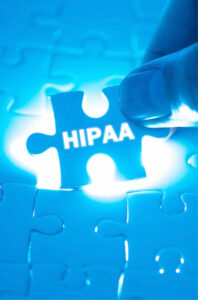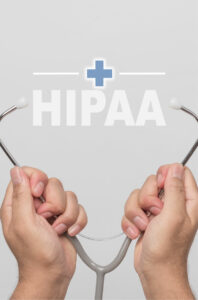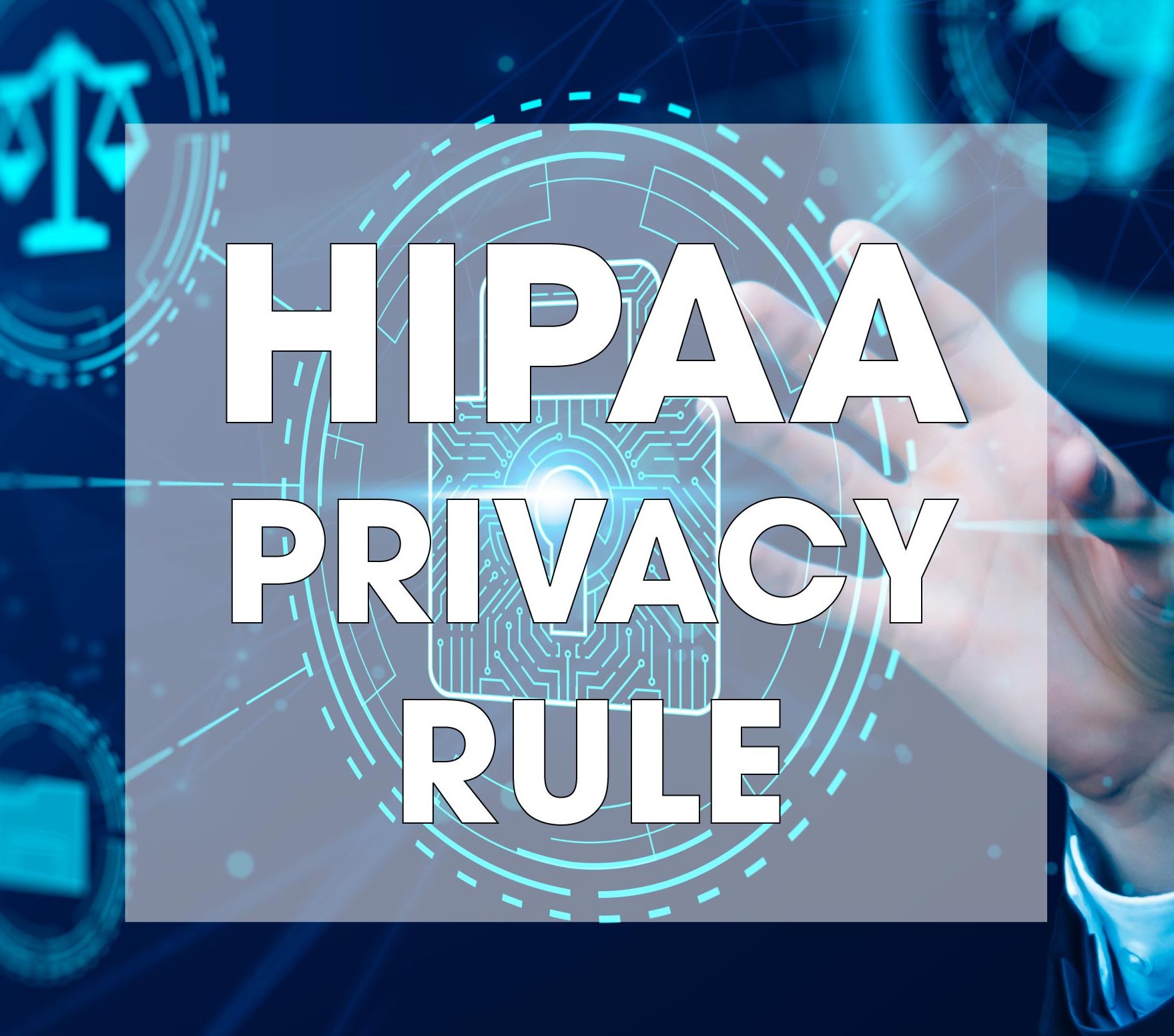
The HIPAA Privacy Rule is a set of federal regulations that protect patients’ medical records and other personal health information maintained by covered entities, including health insurers, healthcare providers, and healthcare clearinghouses, requiring these entities to implement safeguards to protect this data, limit the use and disclosure of such information without patient authorization, provide patients with rights to understand and control how their health information is used, and hold violators accountable with civil and criminal penalties. First enacted in 2002, the HIPAA Privacy Rule protects patient confidentiality. Also known as the “Standards for Privacy of Individually Identifiable Health Information”, the rule maintains the integrity of information whilst still allowing its transfer to other parties when necessary.
The components of the HIPAA Privacy Rule are:
| HIPAA Privacy Rule Components | Description |
|---|---|
| Protected Health Information (PHI) | The Privacy Rule protects all “individually identifiable health information” held or transmitted by a covered entity or its business associate. This includes any form or medium, be it electronic, paper, or oral, known as PHI. |
| Minimum Necessary Standard | Covered entities must make reasonable efforts to limit PHI to the minimum necessary to accomplish the intended purpose of the use, disclosure, or request. |
| Patient’s Rights to Access and Control PHI | Patients have the right to examine and obtain a copy of their health records, to ask for corrections, and to receive an accounting of how their information has been shared. |
| Notice of Privacy Practices | Covered entities are required to provide a notice of their privacy practices. The notice informs patients about their rights and how their information can be used and shared. |
| Authorization for Non-Standard Disclosures | For uses and disclosures not generally allowed by the Privacy Rule, the covered entity must obtain the individual’s written authorization. This typically includes uses for marketing or sales purposes. |
| Administrative Requirements | Covered entities must adopt written privacy procedures, appoint a privacy officer, train their workforce, and apply appropriate sanctions against workforce members who violate the privacy policies. |
| Business Associates Contracts | Covered entities must have contracts with their business associates. These contracts must ensure that the business associates will appropriately use, disclose, and safeguard PHI. |
| Breach Notification | In the event of a breach of unsecured PHI, covered entities must provide notification of the breach to affected individuals, the Secretary of HHS, and, in certain circumstances, to the media. |
| Restriction Request | Individuals have the right to request restrictions on certain uses and disclosures of PHI. Covered entities are not required to agree to these requests, but if they do, they must abide by the agreement. |
| Confidential Communications Requirements | Covered entities must permit individuals to request and must accommodate reasonable requests by individuals to receive communications of PHI by alternative means or at alternative locations. |
Any party that is considered to be a “covered entity” (CE), such as health insurers or healthcare providers, along with their business associates, must abide by HIPAA. This is to ensure that any party that comes across a patient’s Protected Health Information (PHI) maintains its privacy.
The HIPAA Privacy Rule covers names, addresses, social security numbers etc. as well as registration plate numbers and card information. It even protects electronically-stored examples of patient handwriting. This is to ensure that third parties such as health insurers also have a duty to protect patient data. Any images or video footage from which the patient could be easily identified is also protected.
PHI under The HIPAA Privacy Rule
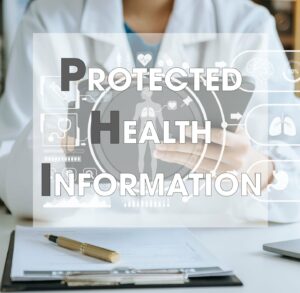
PHI under the HIPAA Privacy Rule refers to all “individually identifiable health information” held or transmitted by a covered entity or its business associate, regardless of the form or medium. This information encompasses any data that can be linked to a specific individual and pertains to the person’s past, present, or future physical or mental health condition, the provision of health care to the individual, or the past, present, or future payment for the provision of health care. PHI is data that can reveal who a person is and provides details about their health status, care, or payment.
The term “individually identifiable health information” is particularly broad. It includes many types of health and identification data that, when combined, could lead to the identification of a specific individual. This information could include names, geographical data smaller than a state, dates (other than year) directly related to an individual, telephone numbers, fax numbers, email addresses, social security numbers, medical record numbers, health insurance beneficiary numbers, account numbers, certificate/license numbers, vehicle identifiers and serial numbers, URLs, IP address numbers, biometric identifiers (like finger and voice prints), and full-face photographic images and comparable images.
De-identified health information, in which these identifiers have been removed, is not considered PHI and thus is not covered by the HIPAA Privacy Rule. For health information to be officially designated as de-identified, either an experienced statistical expert must determine that the risk of re-identification is very low, or the following identifiers of the individual or of relatives, employers, or household members of the individual, must be removed, and there must be no reasonable basis to believe that the remaining information could be used to identify the individual. The latter process is known as the Safe Harbor method. By de-identifying the data, health organizations can use and share information without restriction to aid research and policy development, while still respecting individual privacy.
The HIPAA “Minimum Information Necessary” Requirement
The “Minimum Information Necessary” Requirement is a key principle within the Health Insurance Portability and Accountability Act (HIPAA) Privacy Rule. The principle requires covered entities to limit Protected Health Information (PHI) usage, disclosure, or request to the minimum amount necessary to achieve the intended purpose. The aim is to strengthen privacy protections by preventing unnecessary or inappropriate access to and sharing of PHI. The core idea behind this requirement is that the less PHI exposed or transferred, the lower the risk of it being misused or inadvertently disclosed.
The implementation of the Minimum Necessary Rule is expected to be in line with the covered entity’s role, policies, and practices. While the Rule applies to a wide range of situations, there are some exceptions. For instance, it doesn’t apply to disclosures or requests by a healthcare provider for treatment purposes, disclosures made to the individual themselves, uses or disclosures made under an individual’s authorization, and uses or disclosures required for compliance with the HIPAA Administrative Simplification Rules.
There’s an important role for covered entities to play in determining what constitutes ‘minimum necessary’ in different contexts. They must develop and implement policies and procedures that reasonably limit uses and disclosures to the minimum necessary. When disclosing or requesting PHI, they must review their practices and enhance safeguards as needed to limit unnecessary or inappropriate access to and disclosure of PHI. This may involve designing systems or processes that automatically limit the data shared to the minimum necessary. However, understanding what is ‘minimum necessary’ can be challenging, and entities must use their discretion based on the best judgment in their context.
As well as stipulating the nature of the data to be protected, the Privacy Rule also dictates how the information is to be used and disclosed. Information may be disclosed if it is necessary for treatment or payment of healthcare bills. However, any other information regarding the patient’s medical history can only be disclosed if it is required by law, is in the patient’s interest or if the receiving body is a CE.
Nevertheless, whenever information is transferred, it must be the minimum amount of information necessary for adequate treatment or action. Any non-routine requests for information must be dealt with individually, regardless of whether or not a patient has given prior consent. This does not apply when a complete medical history is required by a healthcare provider.
Patient’s Rights to Access and Control PHI under the HIPAA Privacy Rule
Under the HIPAA Privacy Rule, patients have significant rights regarding their PHI. One of the most important rights is the right to access their own health information. This includes the right to inspect or obtain a copy, or both, of the PHI, as well as to direct the covered entity to transmit a copy to a designated person or entity of the patient’s choice. This applies to PHI in a designated record set, which is basically the medical records and billing records about individuals maintained by or for a covered health care provider, enrolment, payment, claims adjudication, and case or medical management record systems maintained by or for a health plan, or other records used by or for the covered entity to make decisions about individuals.
This access right extends to information held by a covered entity in any form or format, including electronic, paper, or oral, and includes clinical notes; lab and test results; wellness and disease management program files; and medical images like X-ray films. A covered entity may charge a reasonable, cost-based fee for the effort of copying and mailing the record, but it can’t charge for the time spent retrieving the records. The covered entity must provide the access, or send the copy, within 30 days of the patient’s request.
Another important aspect of the patient’s rights to access and control their PHI under the HIPAA Privacy Rule is the right to request amendments or corrections to their PHI. If a patient believes that the information in their record is incorrect or if important information is missing, they have the right to request that the covered entity correct the existing information or add the missing information. The covered entity can deny these requests under certain circumstances, like if they didn’t create the information or if they believe the information is accurate and complete. Patients also have the right to receive a notification if a breach of their unsecured PHI occurs. Moreover, patients have the right to request restrictions on the use and disclosure of their PHI, to receive confidential communications of PHI, and to obtain an accounting of disclosures of their PHI. While covered entities are not required to agree to requests for restrictions, if they do agree, they must comply with the agreed restrictions.
HIPAA Notice of Privacy Practices
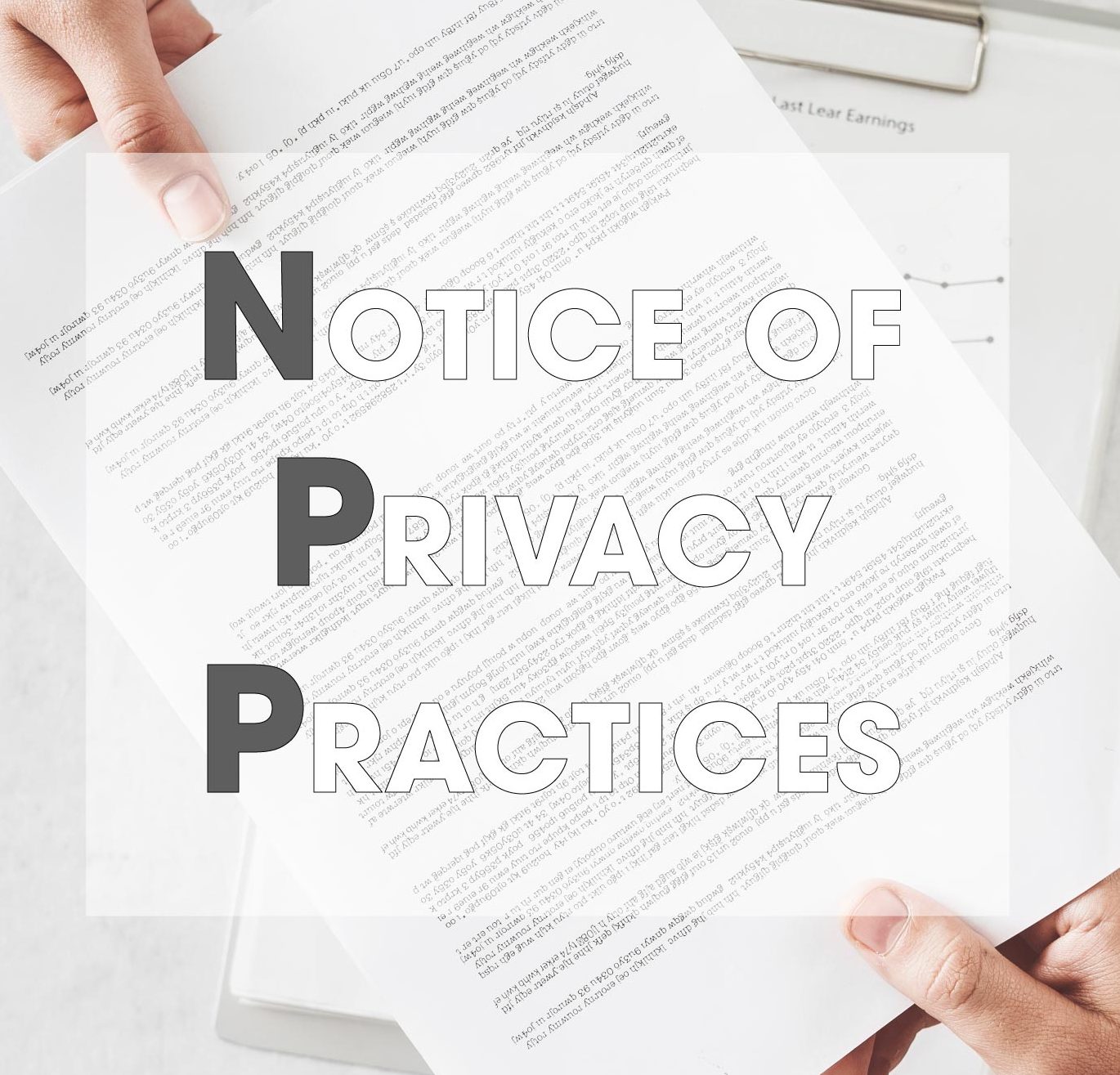
The HIPAA Privacy Rule requires healthcare providers and other covered entities to provide a Notice of Privacy Practices (NPP) to individuals at the first point of service. The NPP is a document that outlines how a patient’s PHI will be used, how it will be protected, and under what circumstances it may be disclosed. It’s essentially a declaration of the patient’s privacy rights and the provider’s legal duties with respect to PHI. It must also contain the procedures for individuals to complain about the covered entity’s privacy practices.
The NPP must be written in plain language to ensure individuals can understand their rights and protections regarding their health information. It must detail the potential uses and disclosures of PHI for treatment, payment, and healthcare operations, along with other purposes permitted or required by the HIPAA Privacy Rule. The notice must also include a statement of the patient’s rights with respect to their health information and how the patient can exercise these rights. For instance, it should explain the patient’s right to access and amend their PHI, to receive an accounting of disclosures, and to request communication of PHI by alternative means or at alternative locations.
Importantly, the Notice of Privacy Practices must be made readily available to patients. It should be prominently displayed and provided to anyone who requests it. In the case of health plans, the notice must be provided to individuals at the time of enrollment and at least once every three years. If the notice is maintained on the health plan’s web site, the individual has a right to request and obtain a paper copy of the notice. For healthcare providers, the notice must be provided to the patient at the first service encounter and posted in a clear and easy-to-find location where it is reasonable to expect patients will be able to read the notice. Any revisions to the notice must be made available upon request, even if the changes have not yet been implemented.
HIPAA Privacy Rule Authorization for Non-Standard Disclosures
The HIPAA Privacy Rule mandates that certain uses and disclosures of PHI may occur only with the patient’s explicit written authorization. These are generally for situations that are not part of standard operations for treatment, payment, or healthcare operations, or as otherwise permitted or required by the Privacy Rule. This means that if a healthcare provider or another covered entity wishes to use or disclose a patient’s PHI for purposes outside the norm, such as for marketing, sales, or research, they must first obtain a specific authorization from the patient.
The written authorization must be in plain language, and it must contain specific information regarding the information being requested for use or disclosure, the person(s) making and receiving the disclosure, the purpose of the disclosure, an expiration date or event, and, in some cases, an explanation of the individual’s right to revoke the authorization. The individual must also be notified of the potential for the information to be re-disclosed by the recipient and no longer protected by the Privacy Rule. The form must be signed by the individual or their representative, and a copy of the signed form must be given to the person signing it.
Authorizations under the HIPAA Privacy Rule are subject to several requirements and restrictions. An authorization is not valid if it does not contain all the necessary components or if the filled-out form has any of the following defects: it has not been filled out completely, it has been revoked, it is expired, it is known by the person relying on it to have been revoked, or its information is known by the person relying on it to be false. It’s crucial to note that patients have the right to revoke their authorization to use or disclose their PHI at any time, but the revocation must be in writing. Once revoked, the healthcare provider or other covered entity cannot continue to use or disclose the individual’s PHI under the previously granted authorization. However, disclosures made prior to the revocation are not affected.
HIPAA Privacy Rule Administrative Requirements
The Administrative Requirements of the HIPAA Privacy Rule mandate that covered entities, including healthcare providers, health plans, and healthcare clearinghouses, implement certain administrative protections to safeguard PHI. These requirements include the development and implementation of privacy policies and procedures, workforce HIPAA training, and designating a privacy official.
Under the HIPAA Privacy Rule, covered entities must develop and implement written privacy policies and procedures that are consistent with the HIPAA Privacy Rule. This means establishing, documenting, and applying policies and procedures for uses and disclosures of PHI and individuals’ rights. These must be reasonable and appropriate for the entity’s size, type, and operations, as well as the sensitivity of the PHI it handles. These policies and procedures must be periodically reviewed and updated in response to changes in the law, standards, technology, and the entity’s business environment.
A important part of the administrative requirements is that a covered entity must designate a privacy official responsible for developing and implementing its privacy policies and procedures. This privacy official will act as the point of contact for all issues related to the HIPAA Privacy Rule. In addition to the privacy official, the covered entity must also train all workforce members on its privacy policies and procedures, as necessary and appropriate for them to carry out their functions. Workforce members include employees, volunteers, trainees, and others whose work performance is under the direct control of the entity, whether or not they are paid by the entity. Finally, covered entities must apply appropriate administrative, technical, and physical safeguards to protect the privacy of PHI from any intentional or unintentional use or disclosure that is in violation of the HIPAA Privacy Rule, and to limit incidental uses or disclosures made pursuant to an otherwise permitted or required use or disclosure. These safeguards must be reasonably appropriate to the entity’s size, the nature of the PHI it holds, and the risks to patients’ privacy.
Business Associates Contracts under the HIPAA Privacy Rule

The HIPAA Privacy Rule requires covered entities, such as healthcare providers and health plans, to have contracts in place with their business associates. A business associate is an individual or entity that performs functions or activities on behalf of a covered entity that involve the use or disclosure of PHI. These contracts, known as Business Associate Agreements (BAAs), establish the parameters and responsibilities for protecting PHI and ensuring compliance with the HIPAA Privacy Rule.
Business Associate Agreements are essential for maintaining the privacy and security of PHI when shared with third-party vendors or service providers. These agreements outline the permitted uses and disclosures of PHI by the business associate, ensuring that they only handle PHI in accordance with HIPAA regulations. The contracts specify that the business associate must appropriately safeguard the PHI, implement necessary security measures, and report any breaches or unauthorized uses or disclosures to the covered entity. The agreements also address other important aspects, such as the requirement for the business associate to comply with the HIPAA Privacy Rule, including providing access to PHI for individuals, cooperating in the event of investigations or audits by the Office for Civil Rights (OCR), and assisting the covered entity in fulfilling its obligations under HIPAA. Business associates must also agree to ensure that any subcontractors they engage also comply with the HIPAA Privacy Rule by signing similar agreements.
The HIPAA Privacy Rule strengthens the accountability and responsibility of business associates by extending the reach of privacy and security requirements beyond the covered entity. These contracts provide an important framework for maintaining the confidentiality, integrity, and availability of PHI while establishing clear expectations and obligations between covered entities and their business associates. By ensuring compliance through Business Associate Agreements, the privacy and security of PHI are safeguarded throughout the healthcare ecosystem.
HIPAA Privacy Breach Notifications
Under the HIPAA Privacy Rule, covered entities and their business associates have specific responsibilities in the event of a breach of unsecured PHI. A breach is generally defined as an impermissible use or disclosure under the Privacy Rule that compromises the security or privacy of the PHI. For an incident to be classified as a breach, it must be determined that the unauthorized disclosure of PHI poses a significant risk of financial, reputational, or other harm to the individual.
When a breach of unsecured PHI occurs, covered entities are required to provide notification of the breach to affected individuals, the Secretary of Health and Human Services (HHS), and, in certain circumstances, to the media. Individual notifications must be provided without unreasonable delay and in no case later than 60 days following the discovery of a breach and must include, to the extent possible, a description of the breach, a description of the types of information that were involved in the breach, the steps affected individuals should take to protect themselves from potential harm, a brief description of what the covered entity is doing to investigate the breach, mitigate the harm, and prevent further breaches, as well as contact information for the covered entity.
In addition to notifying affected individuals and the HHS, if a breach affects more than 500 residents of a State or jurisdiction, the covered entity must provide notice to prominent media outlets serving the State or jurisdiction. For breaches involving less than 500 individuals, the covered entity must notify the Secretary of HHS of such breaches annually. Business associates, when they discover a breach, must notify the covered entity of the breach so that the covered entity can then notify the affected individuals, the HHS, and if applicable, the media. These rules provide a crucial layer of transparency, holding entities accountable and enabling affected individuals to take necessary steps to protect themselves after a breach.
Mobile phones are now ubiquitous, so it is perhaps unsurprising that their use is one of the major threats to PHI security. Bring Your Own Device (BYOD) policies means that if a personal device is stolen, a HIPAA violation has occurred. The Health Information Trust Alliance estimates that around 41% of HIPAA violations are caused by such thefts. However, PHI has value for those of criminal intent. Details from the data may be used in phishing scams, where unsuspecting victims may instructed to download malicious software. Such software may include surveillance malware, which records the input of any usernames and passwords.
Summary of The HIPAA Privacy Rule
The HIPAA Privacy Rule, enacted in 2003, is a federal regulation that establishes national standards for protecting individuals’ medical information and personal health data. It sets forth guidelines for healthcare providers, insurers, and other covered entities to ensure the confidentiality, integrity, and availability of patients’ PHI. The rule outlines patients’ rights regarding their health data, including their right to access, amend, and control the disclosure of their PHI. It also mandates appropriate safeguards, administrative procedures, and documentation requirements to prevent unauthorized access, use, or disclosure of sensitive health information, thereby promoting privacy and maintaining trust in the healthcare system.

FAQs
What is the primary goal of the HIPAA privacy rule?
The primary goal of the HIPAA privacy rule is to establish national standards for protecting individuals’ medical information and personal health data. It aims to strike a balance between ensuring the privacy and confidentiality of patients’ health information while allowing for the appropriate flow of information necessary for healthcare treatment, payment, and operations. By setting these standards, the HIPAA privacy rule aims to enhance individuals’ control over their health information, promote trust in the healthcare system, and facilitate the secure and efficient exchange of health information between covered entities. Ultimately, the goal is to safeguard the privacy and security of protected health information (PHI) and provide individuals with the necessary rights and protections concerning the use and disclosure of their health data.
How does the HIPAA privacy rule define protected health information (PHI)?
The HIPAA privacy rule defines protected health information (PHI) as any individually identifiable health information held or transmitted by covered entities or their business associates in any form or medium. This includes information related to an individual’s past, present, or future physical or mental health condition, healthcare services received, and payment information associated with healthcare services. PHI can include a wide range of data, such as medical records, test results, diagnoses, treatment plans, insurance information, and even demographic details like names, addresses, and social security numbers when they are connected to health information. The definition is broad to encompass various types of health-related data, regardless of the format it is stored or transmitted in, including electronic, paper, or oral forms.
What are the main responsibilities of covered entities under the HIPAA privacy rule?
The main responsibilities of covered entities under the HIPAA privacy rule include safeguarding protected health information (PHI), implementing appropriate administrative, physical, and technical safeguards to protect PHI, and ensuring compliance with the rule’s provisions. Covered entities, such as healthcare providers, health plans, and healthcare clearinghouses, must develop and implement policies and procedures that address the privacy and security of PHI. These entities must designate a privacy official responsible for developing and implementing privacy practices, providing privacy training to employees, and handling complaints and inquiries related to PHI. Covered entities must also establish safeguards to protect PHI from unauthorized access, use, or disclosure, including implementing secure access controls, conducting regular risk assessments, and maintaining physical and technical security measures. Furthermore, covered entities must provide patients with notice of their privacy practices and obtain written authorization from patients before using or disclosing their PHI for purposes beyond treatment, payment, or healthcare operations, except where permitted or required by law.
What rights does the HIPAA privacy rule grant to patients regarding their PHI?
The HIPAA privacy rule grants patients several rights regarding their protected health information (PHI), ensuring that they have control and access to their own health data. These rights include the right to access their PHI, allowing patients to request and obtain copies of their health records from covered entities. Patients also have the right to request amendments to their PHI if they believe it is incomplete or inaccurate, and covered entities must consider these requests and make the appropriate changes when necessary. The HIPAA privacy rule gives patients the right to request restrictions on the use and disclosure of their PHI, such as limiting the information shared with certain individuals or entities. Additionally, patients have the right to receive an accounting of disclosures, which provides them with information about who has accessed or received their PHI. Furthermore, patients can request confidential communications, meaning they can ask covered entities to communicate with them using alternative methods or at specific locations to enhance privacy. Overall, these rights empower patients to have more control over their health information and ensure that their privacy is respected and protected.
Are there any exceptions to the HIPAA privacy rule that allow disclosure of PHI without patient consent?
Yes, there are limited exceptions to the HIPAA privacy rule that permit disclosure of protected health information (PHI) without patient consent, such as for treatment, payment, healthcare operations, public health activities, law enforcement purposes, and emergencies. For example, healthcare providers may disclose PHI without patient consent when it is necessary to provide treatment or coordinate care with other healthcare professionals involved in the patient’s treatment. Similarly, health plans may use or disclose PHI without consent for payment purposes, such as processing claims or sharing information with a third-party payer. Covered entities may also use and disclose PHI for certain healthcare operations, including quality assessment, case management, and other administrative activities. Furthermore, the HIPAA privacy rule allows covered entities to share PHI for public health purposes, such as reporting infectious diseases or conducting disease surveillance. In situations involving law enforcement or emergencies, covered entities may disclose PHI without patient consent to comply with legal obligations or to prevent serious and imminent threats to health and safety. It is important to note that these exceptions have specific requirements and limitations outlined in the HIPAA privacy rule to ensure that disclosures are appropriate and necessary in the given circumstances.
What safeguards does the HIPAA privacy rule require covered entities to implement to protect PHI?
The HIPAA privacy rule requires covered entities to implement a variety of safeguards to protect protected health information (PHI), ensuring its confidentiality, integrity, and availability. These safeguards encompass administrative, physical, and technical measures. Administrative safeguards involve establishing policies, procedures, and training programs to promote privacy and security awareness among employees and workforce members. Covered entities must designate a privacy official responsible for overseeing privacy activities and conducting regular risk assessments to identify and mitigate potential vulnerabilities. Physical safeguards entail implementing physical security measures to protect PHI from unauthorized access, theft, or damage. This may include controlling physical access to facilities where PHI is stored or processed, using locks, access cards, or surveillance systems, and establishing policies for the secure disposal of physical records. Technical safeguards focus on securing electronic PHI (ePHI) and involve measures such as data encryption, strong access controls, audit controls, and regular monitoring of systems for unauthorized access or breaches. These safeguards are crucial for maintaining the privacy and security of PHI and preventing unauthorized use or disclosure, whether in physical or electronic form.
Can covered entities use or disclose PHI for purposes other than treatment, payment, or healthcare operations under the HIPAA privacy rule?
Covered entities can only use or disclose protected health information (PHI) for purposes other than treatment, payment, or healthcare operations if the patient has provided authorization or if it falls within a specific exception outlined in the HIPAA privacy rule. Patient authorization serves as the primary mechanism for covered entities to obtain consent to use or disclose PHI for purposes unrelated to the individual’s direct healthcare needs. Without patient authorization, covered entities generally must limit the use and disclosure of PHI to activities directly related to treatment, payment, and healthcare operations. However, there are some exceptions where PHI can be disclosed without patient authorization, such as for public health activities, disclosures required by law (e.g., reporting child abuse or certain infectious diseases), research purposes with appropriate safeguards, and certain oversight activities conducted by government agencies. These exceptions are designed to balance privacy rights with other important healthcare-related activities and are subject to specific conditions and limitations outlined in the HIPAA privacy rule.
How does the HIPAA privacy rule address the use of electronic health records (EHRs) and digital health information exchange?
The HIPAA privacy rule provides guidelines and requirements for the use of electronic health records (EHRs) and digital health information exchange, aiming to ensure the privacy and security of protected health information (PHI) in the electronic environment. It sets forth standards for covered entities and their business associates to protect the confidentiality, integrity, and availability of EHRs and electronic PHI (ePHI). Covered entities must implement administrative, physical, and technical safeguards to safeguard ePHI from unauthorized access, use, or disclosure. These safeguards include secure user authentication, access controls, encryption of ePHI during transmission and storage, audit trails, and contingency plans for disaster recovery. The HIPAA privacy rule also permits the exchange of PHI for treatment, payment, and healthcare operations purposes between covered entities and other authorized entities, promoting interoperability and secure information sharing while upholding privacy standards. Additionally, the rule provides guidance on individual rights, such as the right to access and obtain a copy of ePHI, ensuring that patients can benefit from the electronic exchange of health information while maintaining control over their own data.
What are the penalties for non-compliance with the HIPAA privacy rule?
Non-compliance with the HIPAA privacy rule can result in various penalties, including civil monetary penalties, criminal penalties, and corrective actions imposed by the Office for Civil Rights (OCR) of the Department of Health and Human Services (HHS). The penalties vary based on the severity of the violation, ranging from $100 to $50,000 per violation, with an annual maximum penalty of $1.5 million for each type of violation category. Civil monetary penalties are assessed based on different tiers, reflecting the level of culpability and the entity’s effort to correct the violation. Willful neglect of the HIPAA privacy rule, where no corrective action is taken, can lead to higher penalties. In cases of deliberate or malicious misuse of PHI, criminal penalties can be imposed, including fines and imprisonment. Additionally, the OCR can require covered entities to implement corrective action plans, conduct risk assessments, and undergo audits to address any compliance deficiencies. The penalties serve as a deterrent and enforcement mechanism to ensure covered entities prioritize privacy and security standards and safeguard individuals’ protected health information (PHI) as required by the HIPAA privacy rule.
What steps must covered entities take to ensure the privacy and security of PHI when transmitting it electronically?
Covered entities must implement appropriate safeguards, such as encryption, secure transmission protocols, and access controls, to ensure the privacy and security of protected health information (PHI) when transmitting it electronically, as mandated by the HIPAA privacy rule. When sending or receiving PHI electronically, covered entities must use encryption or other secure methods to protect the data from unauthorized interception or access. This helps prevent unauthorized individuals from reading or accessing the PHI during transmission. Covered entities must also employ secure transmission protocols, such as secure file transfer protocols (SFTP) or secure email solutions, to ensure that PHI is exchanged securely. Access controls play a vital role in protecting transmitted PHI, requiring covered entities to implement mechanisms to authenticate and verify the identity of individuals accessing the information. This includes the use of unique user identifiers, strong passwords, and multi-factor authentication. By adhering to these safeguards, covered entities can minimize the risk of PHI breaches during electronic transmission, safeguarding patient privacy and maintaining the security of health information.
Can healthcare providers share PHI with family members or friends without patient authorization under the HIPAA privacy rule?
Yes, under certain circumstances, healthcare providers can share protected health information (PHI) with family members or friends without patient authorization if it is deemed to be in the best interest of the patient or if the patient is incapacitated. The HIPAA privacy rule allows healthcare providers to use professional judgment and their ethical obligations to disclose relevant PHI to individuals involved in a patient’s care or payment for healthcare. This may include sharing information with family members, close friends, or other individuals identified by the patient, provided that the provider believes it is in the patient’s best interest and does not conflict with any prior objections from the patient. However, healthcare providers should use their discretion to limit the information disclosed to the minimum necessary for the situation at hand, ensuring that the privacy and confidentiality of the patient’s PHI are maintained to the greatest extent possible.
How does the HIPAA privacy rule address the de-identification of PHI for research purposes?
The HIPAA privacy rule provides guidelines and criteria for the de-identification of protected health information (PHI) to enable its use in research studies, ensuring that any PHI used or disclosed for research purposes does not identify individuals and maintains privacy. The de-identification process involves removing or modifying specific identifiers that could potentially identify individuals, rendering the data anonymous. The HIPAA privacy rule outlines two methods for de-identification: the expert determination method and the safe harbor method. The expert determination method requires the involvement of a qualified statistician or researcher who assesses the risk of re-identification and applies appropriate mitigation techniques. The safe harbor method involves removing specific identifiers listed in the rule, such as names, addresses, social security numbers, and other direct identifiers. Once PHI has been properly de-identified, it is no longer subject to the HIPAA privacy rule’s restrictions and can be used for research purposes without individual consent. By establishing these de-identification standards, the HIPAA privacy rule promotes research while maintaining privacy protections for individuals participating in studies.
Can patients request copies of their PHI from covered entities under the HIPAA privacy rule?
Yes, patients have the right to request and obtain copies of their protected health information (PHI) from covered entities under the HIPAA privacy rule. This right to access their own health information is a fundamental aspect of the privacy rule, enabling patients to review and take control of their healthcare records. Patients can request copies of their PHI in a designated record set, which includes medical records, billing records, and any other records maintained by covered entities for the purpose of making decisions about individuals. Covered entities must provide patients with access to their requested records within a reasonable timeframe, generally within 30 days, and in the format requested by the patient if it is readily producible. However, covered entities may charge a reasonable fee for the cost of copying and mailing the records. This access to PHI allows patients to stay informed about their medical history, facilitate continuity of care, and exercise their rights to monitor and manage their own healthcare.
What are the requirements for covered entities to provide patients with access to their PHI?
Covered entities are required by the HIPAA privacy rule to provide patients with timely access to their protected health information (PHI) upon request, either in the form and format requested by the patient or in a mutually agreed-upon format. The rule outlines specific requirements for covered entities to facilitate patient access to their PHI. Covered entities must respond to patient requests for access within 30 days, although they have the option to extend the response time by an additional 30 days under certain circumstances. However, covered entities should strive to fulfill requests promptly whenever possible. Covered entities must provide access to PHI regardless of whether the information is maintained in paper records, electronic health records (EHRs), or other formats. In cases where the requested format is not readily producible, covered entities should work with patients to agree on an alternative format that is acceptable to both parties. While covered entities may charge a reasonable fee for providing access to PHI, they cannot use fees as a deterrent to prevent patients from accessing their own health information. Providing patients with access to their PHI promotes transparency, empowers individuals to participate in their healthcare decisions, and enhances patient engagement and control over their health information.
How long must covered entities retain PHI records according to the HIPAA privacy rule?
The HIPAA privacy rule does not specify a specific time frame for retaining protected health information (PHI) records. However, covered entities are generally required to retain PHI for at least six years from the date of creation or the date when it was last in effect. This retention period provides a baseline requirement, but covered entities must also comply with any applicable state or federal laws that may impose longer retention periods for specific types of records. It is essential for covered entities to maintain accurate and complete PHI records to ensure continuity of care, support patient rights, facilitate proper billing and reimbursement, and meet legal and regulatory requirements. Proper retention and maintenance of PHI records contribute to the overall privacy, security, and integrity of healthcare data, supporting the principles outlined in the HIPAA privacy rule.
What are the reporting obligations of covered entities in case of a PHI breach under the HIPAA privacy rule?
Covered entities are required to promptly notify affected individuals, the Office for Civil Rights (OCR), and, in some cases, the media in the event of a breach of unsecured protected health information (PHI) as per the reporting obligations outlined in the HIPAA privacy rule. A breach is defined as the unauthorized acquisition, access, use, or disclosure of PHI that compromises its security or privacy. Covered entities must conduct a thorough risk assessment to determine if a breach has occurred, and if so, they must notify affected individuals without undue delay. The notifications must include specific information, such as a description of the breach, the types of information involved, steps individuals should take to protect themselves, and contact information for further details. Additionally, covered entities must report breaches affecting 500 or more individuals to the OCR and, in some cases, notify prominent media outlets serving the affected individuals’ jurisdiction. Timely reporting and notification help individuals take appropriate measures to mitigate potential harm, ensure transparency, and enable the OCR to oversee compliance with breach reporting requirements, ultimately safeguarding individuals’ privacy rights and promoting accountability in the event of a PHI breach.
Does the HIPAA privacy rule apply to business associates of covered entities?
Yes, the HIPAA privacy rule applies not only to covered entities but also to their business associates who handle, use, or disclose protected health information (PHI) on behalf of covered entities. Business associates are individuals or organizations that perform certain functions or services involving PHI, such as billing companies, transcription services, and IT vendors. The HIPAA privacy rule extends the obligations and requirements of the rule to business associates through contractual agreements known as business associate agreements (BAAs). These agreements establish the responsibilities of business associates to protect PHI and comply with the privacy and security provisions of the HIPAA privacy rule. Business associates are required to implement appropriate safeguards, report breaches to covered entities, and adhere to the same standards for the use and disclosure of PHI as covered entities. This ensures that PHI remains protected even when shared with external entities, maintaining the overall integrity and privacy of individuals’ health information.
Can patients file complaints with the Office for Civil Rights (OCR) if they believe their privacy rights have been violated under the HIPAA privacy rule?
Yes, patients have the right to file complaints with the Office for Civil Rights (OCR) if they believe their privacy rights under the HIPAA privacy rule have been violated. The OCR is the agency responsible for enforcing the HIPAA privacy rule and ensuring compliance. Patients can submit complaints to the OCR by providing relevant information about the alleged violation and the covered entity or business associate involved. The OCR investigates complaints and takes appropriate action, which may include providing technical assistance to covered entities, conducting compliance reviews, imposing penalties for non-compliance, and mediating resolutions between parties. The ability to file complaints empowers individuals to hold covered entities and business associates accountable for any potential privacy breaches or violations of their rights under the HIPAA privacy rule. By addressing complaints, the OCR helps maintain the integrity of the healthcare system, upholds patient privacy, and promotes compliance with the privacy rule’s provisions.
Are there any special considerations or guidelines for the use and disclosure of psychotherapy notes under the HIPAA privacy rule?
Yes, the HIPAA privacy rule contains special considerations and guidelines for the use and disclosure of psychotherapy notes, providing additional protection for these specific types of mental health treatment records. Psychotherapy notes are separate from regular medical records and contain a therapist’s personal observations and analysis from a counseling session. The HIPAA privacy rule affords psychotherapy notes heightened privacy protections, considering them as distinctly sensitive information. In general, covered entities are required to obtain a patient’s written authorization before using or disclosing psychotherapy notes for most purposes, including treatment, payment, and healthcare operations. This requirement ensures that patients have explicit control over the disclosure of this sensitive information. However, there are limited exceptions where psychotherapy notes can be used or disclosed without patient authorization, such as for the therapist’s own training, consultations with other mental health professionals, or when required by law. These special considerations recognize the unique nature of psychotherapy notes and emphasize the importance of safeguarding the privacy and confidentiality of individuals seeking mental health treatment.
How does the HIPAA privacy rule address the privacy and security of PHI in research studies and clinical trials?
The HIPAA privacy rule includes provisions that allow for the use and disclosure of protected health information (PHI) in research studies and clinical trials, with certain privacy safeguards in place to protect the rights and confidentiality of individuals participating in these activities. The rule permits covered entities to use and disclose PHI for research purposes when authorized by the individual or when the research project has received an appropriate waiver of authorization. However, covered entities must ensure that the researcher follows specific privacy safeguards, such as obtaining approval from an institutional review board (IRB) or privacy board, implementing data security measures, and ensuring that PHI is only used or disclosed as necessary for the research. The HIPAA privacy rule requires covered entities to apply reasonable efforts to de-identify PHI used for research whenever feasible, protecting the privacy of individuals’ health information. Furthermore, covered entities must maintain appropriate documentation and agreements with researchers to establish privacy and security safeguards and monitor compliance. These provisions strike a balance between supporting valuable medical research and protecting the privacy and confidentiality of individuals involved in research studies and clinical trials, aligning with the principles of the HIPAA privacy rule.
Photo Credit: stock.adobe.com



